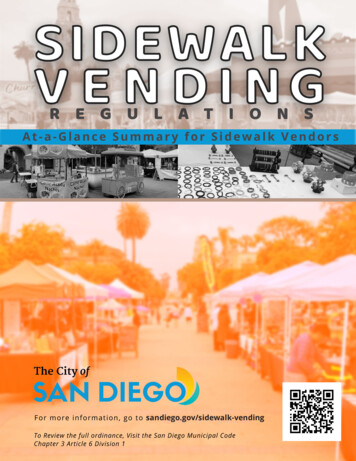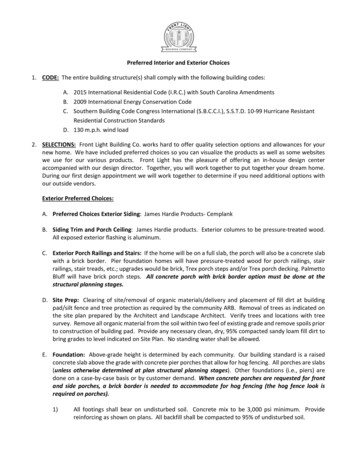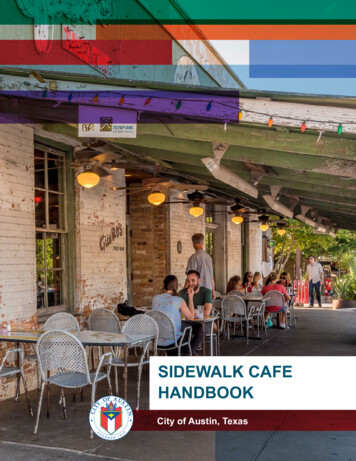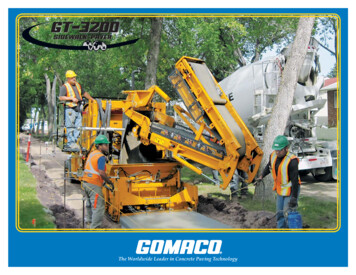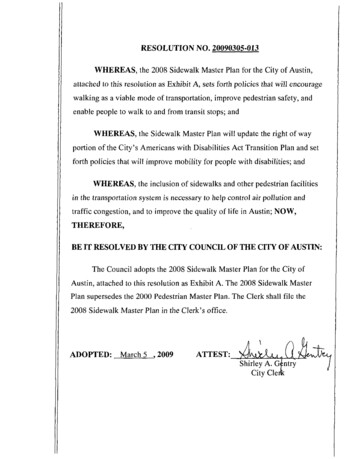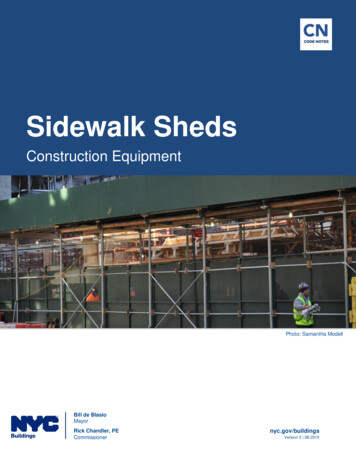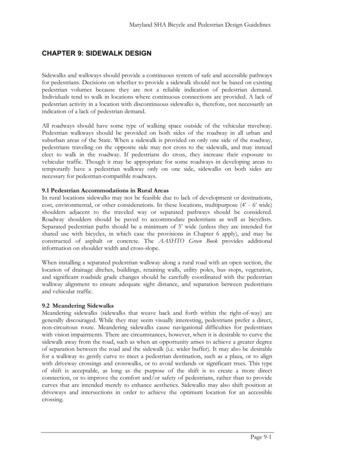
Transcription
Maryland SHA Bicycle and Pedestrian Design GuidelinesCHAPTER 9: SIDEWALK DESIGNSidewalks and walkways should provide a continuous system of safe and accessible pathwaysfor pedestrians. Decisions on whether to provide a sidewalk should not be based on existingpedestrian volumes because they are not a reliable indication of pedestrian demand.Individuals tend to walk in locations where continuous connections are provided. A lack ofpedestrian activity in a location with discontinuous sidewalks is, therefore, not necessarily anindication of a lack of pedestrian demand.All roadways should have some type of walking space outside of the vehicular travelway.Pedestrian walkways should be provided on both sides of the roadway in all urban andsuburban areas of the State. When a sidewalk is provided on only one side of the roadway,pedestrians traveling on the opposite side may not cross to the sidewalk, and may insteadelect to walk in the roadway. If pedestrians do cross, they increase their exposure tovehicular traffic. Though it may be appropriate for some roadways in developing areas totemporarily have a pedestrian walkway only on one side, sidewalks on both sides arenecessary for pedestrian-compatible roadways.9.1 Pedestrian Accommodations in Rural AreasIn rural locations sidewalks may not be feasible due to lack of development or destinations,cost, environmental, or other considerations. In these locations, multipurpose (4’ - 6’ wide)shoulders adjacent to the traveled way or separated pathways should be considered.Roadway shoulders should be paved to accommodate pedestrians as well as bicyclists.Separated pedestrian paths should be a minimum of 5’ wide (unless they are intended forshared use with bicycles, in which case the provisions in Chapter 6 apply), and may beconstructed of asphalt or concrete. The AASHTO Green Book provides additionalinformation on shoulder width and cross-slope.When installing a separated pedestrian walkway along a rural road with an open section, thelocation of drainage ditches, buildings, retaining walls, utility poles, bus stops, vegetation,and significant roadside grade changes should be carefully coordinated with the pedestrianwalkway alignment to ensure adequate sight distance, and separation between pedestriansand vehicular traffic.9.2 Meandering SidewalksMeandering sidewalks (sidewalks that weave back and forth within the right-of-way) aregenerally discouraged. While they may seem visually interesting, pedestrians prefer a direct,non-circuitous route. Meandering sidewalks cause navigational difficulties for pedestrianswith vision impairments. There are circumstances, however, when it is desirable to curve thesidewalk away from the road, such as when an opportunity arises to achieve a greater degreeof separation between the road and the sidewalk (i.e. wider buffer). It may also be desirablefor a walkway to gently curve to meet a pedestrian destination, such as a plaza, or to alignwith driveway crossings and crosswalks, or to avoid wetlands or significant trees. This typeof shift is acceptable, as long as the purpose of the shift is to create a more directconnection, or to improve the comfort and/or safety of pedestrians, rather than to providecurves that are intended merely to enhance aesthetics. Sidewalks may also shift position atdriveways and intersections in order to achieve the optimum location for an accessiblecrossing.Page 9-1
Maryland SHA Bicycle and Pedestrian Design Guidelines9.3 Sidewalk DesignFigure 9.1 shows guidelines for the design of sidewalks, including widthand cross slopes.Sidewalk Buffer ZoneA pedestrian’s safety and comfort in the roadway environment is largelydependent on the width and quality of the buffer between the sidewalkand the roadway. Physical barriers between the sidewalk and roadway(such as street trees, landscaping, bike lanes and parked cars) will increasepedestrian safety and comfort, and therefore encourage higher levels ofwalking.On-street parking has a very positive effect on pedestrian comfort. Alongsome arterial and collector streets in areas that are seeking to enhanceand/or introduce a traditional commercial core (with stores/businesses infront and parking lots behind), it may be feasible to add on-street parkinglanes.Approved tree species for SHA rights-of-way and public easements arelisted in the “Roadside Tree Law Recommended Tree List.” For narrowlandscape buffers less than 5 feet wide, care should be taken to use shadetree species that can survive in a narrower space and have less invasiveroot systems, such as varieties of maple and oak trees. Large shade treesare preferred to medium and small trees that do not offer as much shade.Figure 9.2 - Example of a GreatSidewalkStreet trees should typically be placed no closer than 30 feet on center,and no greater than 60 feet on center, depending on the species of tree.In locations with no buffer strip, consideration can be given to providingtree planting behind the sidewalk, which may improve aestheticconditions and provide shade, but will not improve pedestrians’ sense ofsafety in the roadway environment. Planting trees behind the sidewalkshould not be done in new developments or retrofits (such as a road diet)where there is room for a buffered planting strip. Street trees should notbe positioned so as to block sight distances at intersections anddriveways.Figure 9.3 - Example: of aSidewalk with Buffer ZoneIn retrofit locations where the sidewalk is unavoidably placed adjacent tothe curb, an additional 2-feet of sidewalk width should be provided.Sidewalks placed directly adjacent to retaining walls or other vertical obstructions should alsobe increased in width by 2-feet.9.4 Curb Ramp DesignFor guidance on curb ramps and other accessibility issues, refer to SHA’s Accessibility Policy &Guidelines for Pedestrian Facilities along State Highways. In the past, some engineers have deniedrequests for curb ramps in an effort to discourage crossing at uncontrolled legs ofintersections. Pedestrians have a legal right to cross the roadway at uncontrolled crosswalksand when curb ramps are not provided at legal crossings, some pedestrians are physicallyunable to do so. For this reason, it is necessary to provide curb ramps at uncontrolledlocations (such as “T” intersections) as well as conventional four-legged intersections.Curb ramps are also needed at the ends of sidewalks where they do not terminate at anintersection, so that pedestrians can safely access the roadway shoulder.Page 9-2
Maryland SHA Bicycle and Pedestrian Design GuidelinesHandrails on SidewalksHandrails are required when the through pedestrian zone is adjacent to a vertical drop of 2.5’or more. Sidewalks with running slopes less than or equal to the slopes of the adjacentroadway are not considered ramps, even when they are at grades greater than 5%. As aresult, they are exempt from the requirements for running slope in the Americans withDisabilities Act, including the requirements for handrails.9.5 Sidewalk Design on Bifurcated RoadwaysFor the purpose of this document, a bifurcated roadwayis one where the sidewalks are raised above or set belowthe elevation of the roadway. Bifurcation is typicallyused in environmentally sensitive areas or hilly terrainand is often accomplished with the use of roadsidebarriers and small retaining walls. See Figure 9.4 formore information.9.6 Options for when Street and BuildingEntrances are at Different ElevationsSometimes building entrances are at different elevationsthan the adjacent sidewalks. Figure 9.5 provides fouroptions for maintaining accessibility in these situations.9.7 Entrance/Driveway DesignStandards for the design of driveway entrances arediscussed in the Maryland State Highway Access Manual(SHA). The Access Manual describes six different types ofentrances: 1) depressed curb entrances (which includeboth residential and commercial applications); 2)commercial two-way entrances; 3) commercial one-wayentrances; 4) commercial right-in/right-out entrances; 5)monumental entrances; and 6) special entrance designs.All six different entrance types will not be discussed indetail here except to describe design considerations forpedestrians.Depressed curb entrances have flared sides and are whatmost designers think of as driveways (examples areshown in Figures 9.7, 9.8, and 9.9). They are thepreferred type of entrance for locations where pedestrianvolume is expected to be high. A sidewalk that remainslevel across a driveway best meets the intent of ADAand most accurately reflects the fact that pedestrianshave the right-of-way on sidewalks.Figure 9.6 - Example of Building Entrance Higherthan SidewalkFigure 9.9 - Example of a Continuous PedestrianRoute over a Depressed Curb Entrance where thereis a Buffer between the Sidewalk and the Curb (Anexample application of Standard No. 630.02)All of the remaining types of entrances are between curbed sides and therefore functionmuch like roadway intersections (an example is shown in Figure 9.10). According to theHighway Access Manual depressed curb entrances are appropriate as follows:xxDepressed curb entrances are appropriate for use along lower speed highways in urbansettings, where significant pedestrian traffic is anticipated and highway capacity issuesare not a primary concern. The posted speed should be no higher than 40 mph.The use of depressed curb entrances is restricted to undivided highways and dividedhighways that have a raised median.Page 9-4
Maryland SHA Bicycle and Pedestrian Design GuidelinesxxxDepressed curb entrances are not appropriate forone-way entrances.Depressed curb entrances should be reserved forsites that will not generate sufficient traffic to have asignificant effect on the highway traffic stream.Depressed curb entrances shall not be used onprimary highways, in the interest of minimizingtraffic interference due to turning vehicles.The Book of Standards for Highway & Incidental Structuresincludes details for different methods of constructingdepressed curb entrances for residential and commercialuse (SHA). For the design of sidewalks in relation todepressed curb entrances, see Standard Numbers 630.01and 630.02. The best driveway entrances are in locationswhere there is a 24 inch or greater buffer zone betweenthe sidewalk and the curb. Standard Number 630.02 isused in these locations (see Figure 9.9). This is the mostdesirable type of driveway entrance because pedestriansare not deflected horizontally or vertically from theirpath of travel. In locations without a buffer zone or inlocations where the buffer zone is less than 24 inches,Standard Number 630.01 should be used. StandardNumber 630.01 requires that pedestrians are deflectedhorizontally, vertically, or both from their path of travel(See Figure 9.7 and 9.8).Both standards 630.01 and 630.02 maintain an accessibleroute over the entrance, which is required by SHA’sAccessibility Policy & Guidelines for Pedestrian Facilities alongState Highways and the Americans with Disabilities Act(maximum cross slope is 2%). In locations withnumerous entrances it is important to remember thatpedestrians are sensitive to increases in walking distancewhich may result from horizontal deflection of thesidewalk around the entrance. This sort of deflectionmay be especially problematic to pedestrians with visionimpairments because they may have trouble followingthe sidewalk. Additionally if entrances are frequent,pedestrians with mobility impairments may havedifficulty negotiating the numerous changes in gradewhen the sidewalk ramps down to the entrance.Figure 9.8 - Example of a Continuous PedestrianRoute over a Depressed Curb Entrance withHorizontal Deflection (An example application ofStandard No. 630.01)Figure 9.9 - Example of a Continuous PedestrianRoute over a Depressed Curb Entrance withVertical Deflection (An example application ofStandard No. 630.01)In designing depressed curb entrances it is alsoimportant that the curb becomes flush with the gutter.Lips at the mouth of driveways have been known tocause crashes by bicyclists when entering the driveway ata shallow angle.In locations where depressed curb entrances are notappropriate, the Access Manual recommends commercialFigure 9.10 - Example of a Commercial Two-WayEntrancePage 9-7
Maryland SHA Bicycle and Pedestrian Design Guidelinestwo-way entrances, commercial one-way entrances, commercial right-in/right-out entrancesand monumental entrances. These types of entrances function like roadway intersections andshould contain the same pedestrian safety features as intersections. Curb ramps, detectablewarnings, and crosswalk markings should be used to provide a continuous and accessiblepedestrian route as described in this design guide and the Accessibility Policy & Guidelines forPedestrian Facilities along State Highways. Additionally, pedestrians should be given theopportunity to cross the public street at major commercial entrance locations as they wouldat an intersection of two roadways.Page 9-8
Individuals tend to walk in locations where continuous connections are provided. A lack of pedestrian activity in a location with discontinuous sidewalks is, therefore, not necessarily an indication of a lack of pedestrian demand. All roadways should have some type of walking space outside of the vehicular travelway.


